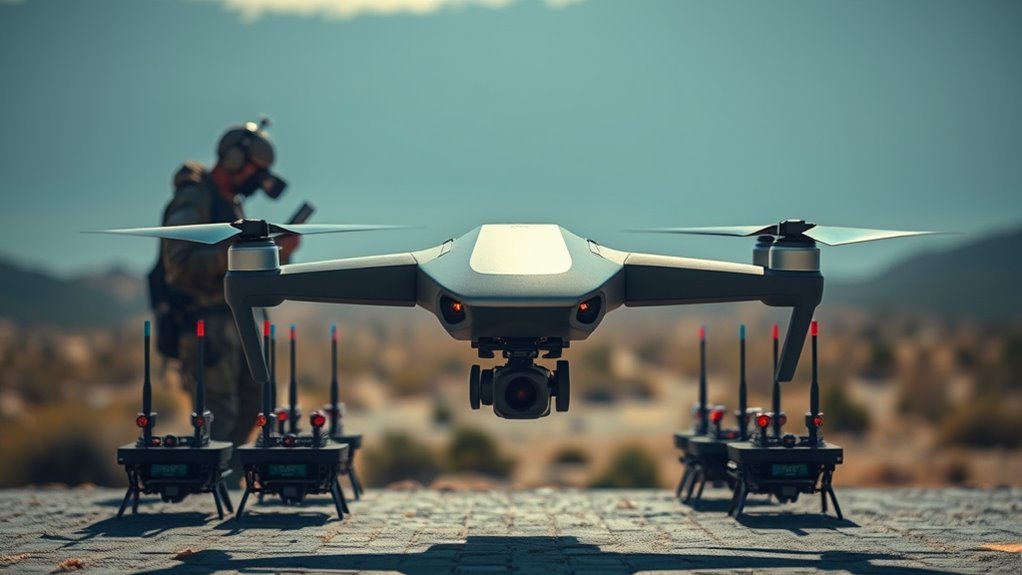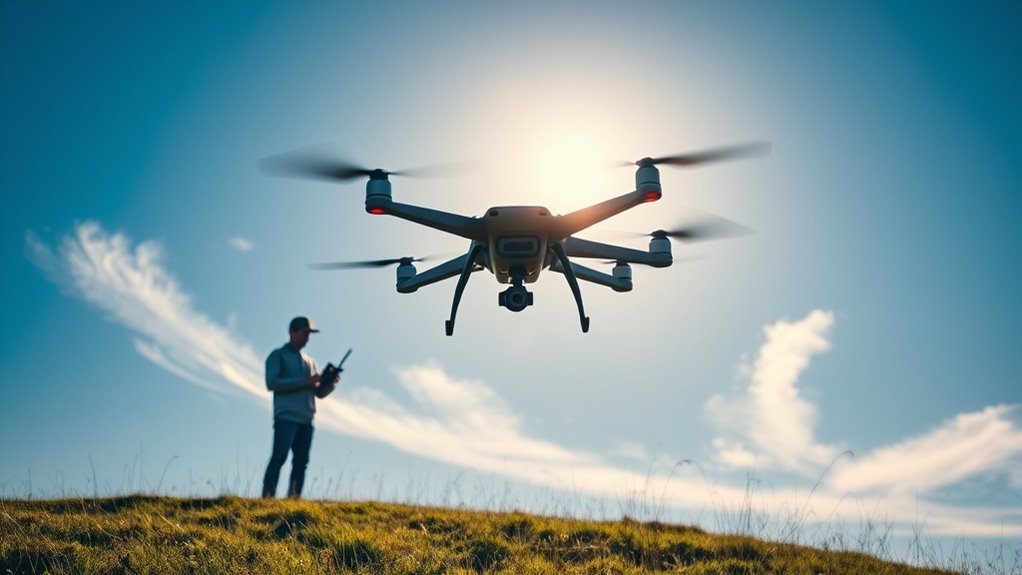To effectively jam drones, you need to understand their vulnerabilities, especially in signal transmission. Start by ensuring compliance with legal regulations to avoid penalties and fines. Use techniques like frequency jamming, spoofing, or noise jamming to disrupt communication. Equip yourself with suitable tools like portable jammers that target specific frequencies. Adapt your strategies based on real-time drone behavior and technological advancements for maximum effectiveness. There’s more to explore to enhance your jamming approach.
Understanding Drone Technology and Its Vulnerabilities

As drone technology continues to evolve, understanding its inherent vulnerabilities becomes essential for effective countermeasures. Drones rely on various components, including sensors, cameras, and communication systems, all of which are critical for their operation. The most significant vulnerability lies in their signal transmission pathways. These pathways are susceptible to interference, which can disrupt the drone’s ability to receive commands or transmit data. By identifying the specific frequencies and protocols used in signal transmission, you can exploit these weaknesses. Understanding the architecture of drone components allows you to develop targeted jamming techniques that can effectively neutralize unauthorized drone activity. Additionally, recognizing the impact of advanced battery technology on drone performance can inform your countermeasures. For instance, the power-to-weight ratio plays a crucial role in determining how quickly a drone can respond to commands, making it an important factor to consider in your strategies. Recognizing these vulnerabilities not only enhances your preparedness but also empowers you to safeguard your freedom against potential drone incursions.
Legal Considerations for Drone Jamming

While jamming drones may seem like a straightforward approach to mitigating unauthorized incursions, the legal implications are complex and critical to understand. Engaging in drone jamming without proper authorization can lead to serious legal consequences, including hefty fines and potential criminal charges. It’s vital to guarantee regulatory compliance with federal and local laws, as many jurisdictions strictly prohibit signal interference. You must also consider the potential impact on nearby communications and other technologies. If you’re contemplating jamming techniques, consult with legal experts to navigate these intricacies. Understanding the legal landscape not only protects you but also helps maintain the delicate balance between security measures and individual freedoms. Always prioritize legality to avoid unintended repercussions.
Types of Drone Jamming Techniques

When considering effective strategies for jamming drones, it is essential to understand the various techniques available. You’ll find that different jamming methods employ unique approaches to create signal interference, maximizing disruption. Below is a summary of key techniques:
| Technique | Description |
|---|---|
| Frequency Jamming | Disrupts specific frequency bands |
| Spoofing | Mimics legitimate signals to mislead |
| Burst Jamming | Sends short bursts of interference |
| Noise Jamming | Generates random noise across bands |
| Deceptive Jamming | Misguides the drone’s navigation |
Familiarizing yourself with these jamming devices allows for informed choices, enhancing your ability to protect your space and maintain control over your environment.
Implementing Jamming Solutions: Tools and Equipment
To effectively implement jamming solutions, you need to select the right tools and equipment tailored to your specific operational environment. Start by evaluating your target drones’ communication frequencies to determine the appropriate jamming devices. These devices should be capable of generating frequency interference across a range of signals, disrupting the drone’s control and communication links. Consider portable jammers for mobility or fixed installations for permanent setups, depending on your needs. Additionally, verify your equipment complies with legal regulations in your area to avoid legal repercussions. Always keep in mind the importance of strategic deployment, as the effectiveness of your jamming solutions hinges on choosing the right tools that align with your operational goals and environmental factors.
Best Practices for Effective Drone Jamming
Effective drone jamming requires a strategic approach that incorporates both technical proficiency and situational awareness. First, assess the operational environment to identify potential threats and their communication frequencies. Utilize diverse jamming strategies, such as frequency hopping and pulse jamming, to maximize signal interference. It’s essential to adapt your tactics in real-time; drones may switch frequencies or employ countermeasures. Employ directional antennas to focus your jamming efforts, enhancing effectiveness while minimizing collateral disruptions. Additionally, maintain a clear understanding of legal limitations to guarantee compliance and protect your rights. Finally, continuously monitor the jamming landscape; technological advancements can alter the effectiveness of your equipment. By integrating these best practices, you’ll enhance your capability to effectively jam unwanted drone activity.
Frequently Asked Questions
Can Jamming Devices Harm Nearby Electronic Equipment?
Yes, jamming devices can potentially harm nearby electronic equipment due to their jamming impact, which creates electronic interference. It’s important to assess the risk before deployment to avoid unintended damage to your own devices.
How Do I Choose the Right Jamming Frequency?
To select the right jamming frequency, analyze the drone communication protocols in use. You’ll need to identify their operational bands and then choose frequencies that effectively disrupt those signals without affecting other critical electronic systems nearby.
Are There Specific Drones That Are More Vulnerable to Jamming?
When it comes to vulnerability factors, certain drone models are indeed more susceptible to jamming. You’ll find consumer-grade drones often lack robust defenses, making them easy targets in the right conditions. Stay informed to maximize your effectiveness.
What Are the Risks of Using Homemade Jamming Devices?
Using homemade jamming devices poses significant legal implications and safety concerns. You risk violating regulations, causing interference with critical communications, and potentially endangering public safety, which can lead to severe penalties and legal consequences.
How Can I Test the Effectiveness of My Jamming Solution?
To test your jamming effectiveness, employ various testing methods like field trials with drones at varying distances and interference types. Analyze signal strength and response times to gauge how well your solution disrupts communications.

